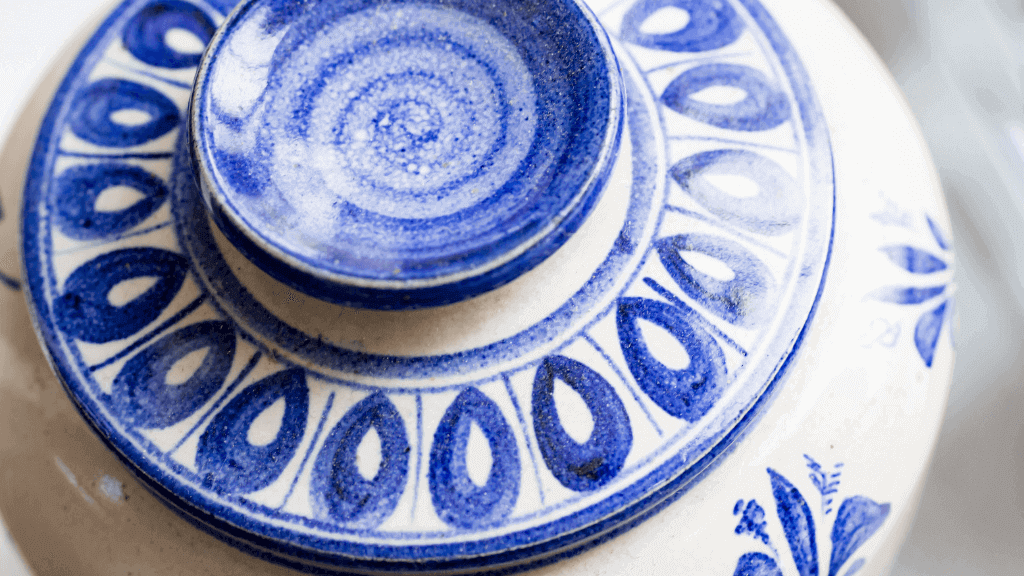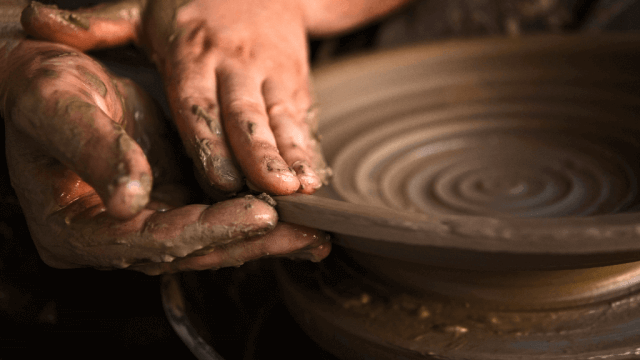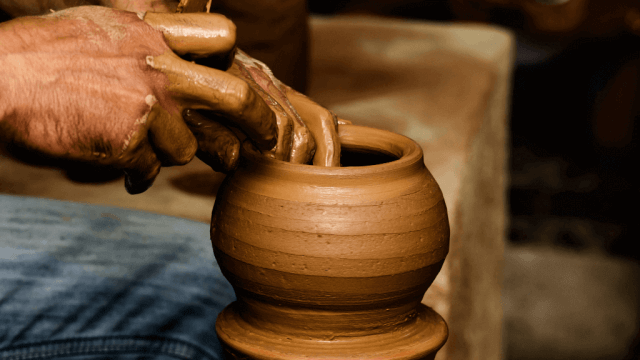Delft pottery, also known as Delftware or Delft Blue, is a type of tin-glazed earthenware originating from the city of Delft in the Netherlands during the 17th century. It is characterized by its distinctive blue and white designs, often depicting scenes from Dutch life, floral patterns, or historical events. The pottery was initially developed as an affordable alternative to Chinese porcelain and became popular across Europe.
Origins of Delft Pottery
The history of Delft pottery dates back to the 17th century, when the Dutch East India Company began importing Chinese porcelain. Intrigued by its beauty and enamored by its delicate, white surface, Dutch potters set out to develop a local and affordable alternative. In doing so, they created Delftware, a type of tin-glazed earthenware that emulated the blue and white designs of Chinese pottery.
Characteristics of Delftware
Delftware is characterized by its shiny, tin-glazed surface, which is fired at a lower temperature than porcelain, making it more affordable but less durable. The pottery’s distinct blue and white designs, created using cobalt oxide, often feature traditional Dutch scenes, floral patterns, and chinoiserie motifs reminiscent of Chinese porcelain.
Tin-Glazed Earthenware
The key to Delft pottery’s unique appearance is tin-glazed earthenware, a type of pottery in which a tin oxide glaze is applied to an earthenware body. This technique creates a smooth, white surface ideal for intricate hand-painted decorations. Tin glazing was first used in the Middle East and later spread to Europe, where it gained popularity in areas such as Italy and Spain before finally making its way to the Netherlands.
Iconic Blue and White Designs
The blue and white color scheme used in Delft pottery is a homage to Chinese porcelain. Cobalt oxide is used to create the intense, vibrant shade of blue, which is paired with the white tin-glazed surface to produce designs that instantly recognizable. Over time, Delftware designs have expanded to include other colors and styles, but the classic blue and white combination remains the most sought after.
Production Process of Delft Pottery
The process of creating authentic Delftware involves multiple steps, including preparing the clay, applying the tin glaze, hand-painting the designs, and firing the pottery.
Clay Preparation and Shaping
The first step in making Delft pottery is the preparation of the clay, which typically consists of a mixture of local and imported clay. The clay is kneaded to remove air bubbles and achieve a uniform consistency before it is shaped using various methods such as wheel throwing, molding, or press molding. Once the pottery has been formed, it is left to dry for several days.
Applying Tin Glaze
After the pottery is shaped and dried, it is coated with a layer of tin oxide glaze. This glaze contains a mixture of powdered glass, white lead, and tin ash, suspended in water. When applied to the pottery and fired in a kiln, the glaze turns into a white, glossy surface, providing an ideal canvas for the hand-painted designs.
Hand-Painting the Designs
Once the tin glaze has been applied, the pottery is decorated with blue and white designs using a paintbrush and cobalt oxide. Master Delftware painters and apprentices alike hand-paint traditional patterns and designs onto the pottery, ensuring that each piece is a unique work of art.
Firing the Pottery
Finally, the painted pottery is fired in a kiln at approximately 1,600 degrees Fahrenheit (900 degrees Celsius) to solidify the tin glaze and permanently render the blue design. The final product is a piece of beautiful, uniquely Dutch Delft pottery.
Delft Pottery in the Age of Dutch Golden Age
The Dutch Golden Age in the 17th century was a period of unprecedented artistic, scientific, and economic growth. It was during this time that Delft pottery gained considerable popularity and commercial success. As the demand for this unique earthenware grew, a large number of factories emerged across the city of Delft, employing skilled artisans and painters to produce exquisite pieces. Soon, Delftware became a symbol of wealth and status, adorning the homes of affluent families across Europe and beyond.
Collecting and Identifying Authentic Delftware
Authentic Delftware is highly sought after by collectors, as it represents an important part of Dutch history and artisanship. To determine the authenticity and age of a piece of Delft pottery, collectors must be aware of various telltale signs:
Maker’s Marks and Signatures
Reputable Delftware factories typically marked their pottery with maker’s marks or signatures. These marks are unique to each factory or artist and can provide valuable information about the piece’s origin and production date. Antique Delft pottery may bear marks such as a factory’s logo or an artist’s signature or monogram. Familiarizing yourself with these marks can help identify authentic pieces.
Quality of Design and Workmanship
The quality of design and workmanship is another vital aspect to consider when collecting Delft pottery. Authentic Delftware exhibits precise and detailed brushstrokes, demonstrating the skill and expertise of the painters. The color should be consistent, with no signs of smudging or bleeding. Additionally, the tin glaze should be smooth and uniform, with minimal blemishes or imperfections.
Pottery Form and Style
Examining the pottery’s form and style is essential for understanding its origin and dating. Traditional Delftware often consists of functional items such as plates, vases, and tiles, as well as decorative figurines. Investigating historical records and catalogs can provide valuable information about documented styles and forms, giving collectors insights into their authenticity.
Maintenance and Care for Delft Pottery
Due to its tin-glazed earthenware construction, Delft pottery is more fragile compared to porcelain. As such, proper care and maintenance are critical to prevent damage and preserve its beauty and value. Here are some tips for caring for your Delftware collection:
Cleaning and Handling
Always handle Delft pottery with clean hands and avoid touching the painted surface to prevent damage or transfer of oils. When cleaning the pottery, use a soft, damp cloth to gently wipe its surface, avoiding any abrasive materials. For more delicate pieces or those with intricate designs, use a soft-bristle brush to avoid damaging the paint.
Storage and Display
Store and display your Delft pottery in a stable, secure location to minimize the risk of accidental falls or impacts that could cause damage. Cabinets with adjustable glass shelves or wall-mounted shelves are a safe option. Avoid direct sunlight or extreme temperature fluctuations, as these can lead to cracks or fading of the paint. Regularly inspect your collection for signs of wear or damage, and address any issues promptly to preserve its value.
FAQ Section: Delft Pottery
Here are answers to some common questions pertaining to Delft pottery, its history, the production process, and other relevant information.
Is Delft pottery the same as porcelain?
No, Delft pottery is not the same as porcelain. It is a tin-glazed earthenware, whereas porcelain is a type of ceramic made from fine, white kaolin clay and fired at high temperatures. Although Delftware was initially developed as an alternative to Chinese porcelain, it is not as durable or translucent as porcelain due to differences in materials and production techniques.
How can I tell if my Delft pottery is authentic?
There are several indicators of authentic Delft pottery, including maker’s marks or signatures, quality of design and workmanship, and the form and style of the piece. By familiarizing yourself with these characteristics and conducting research on established artists and factories, you can determine the authenticity of your Delftware.
What types of items are commonly found in Delft pottery?
Delft pottery is commonly produced in a variety of forms, such as plates, vases, tiles, teapots, and decorative figurines. These pieces often feature traditional Dutch scenes, floral patterns, or chinoiserie designs as an homage to its Chinese porcelain inspiration.
What is the significance of the blue and white color scheme in Delft pottery?
The blue and white color scheme is significant in Delft pottery, as it is an emulation of Chinese porcelain, which features similar colors. Dutch potters utilized cobalt oxide to achieve the striking blue hue, and when paired with the white tin-glazed surface, the result is a distinctive and recognizable design characteristic of Delftware.
How should I care for and maintain my Delft pottery?
Proper care and maintenance are essential for preserving the beauty and value of your Delft pottery. Handle it with clean hands, and clean it with a soft, damp cloth to avoid abrasions. Display and store your Delftware securely, avoiding direct sunlight or extreme temperature fluctuations. Regular inspections can help identify wear or damage early, allowing you to address any issues promptly.











